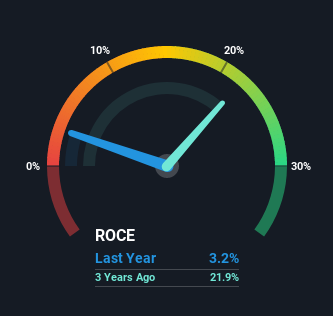- France
- /
- Professional Services
- /
- ENXTPA:ALDLS
Returns On Capital Signal Tricky Times Ahead For DLSI (EPA:ALDLS)
If we want to find a stock that could multiply over the long term, what are the underlying trends we should look for? One common approach is to try and find a company with returns on capital employed (ROCE) that are increasing, in conjunction with a growing amount of capital employed. Ultimately, this demonstrates that it's a business that is reinvesting profits at increasing rates of return. However, after investigating DLSI (EPA:ALDLS), we don't think it's current trends fit the mold of a multi-bagger.
Understanding Return On Capital Employed (ROCE)
For those that aren't sure what ROCE is, it measures the amount of pre-tax profits a company can generate from the capital employed in its business. The formula for this calculation on DLSI is:
Return on Capital Employed = Earnings Before Interest and Tax (EBIT) ÷ (Total Assets - Current Liabilities)
0.032 = €1.8m ÷ (€115m - €57m) (Based on the trailing twelve months to December 2020).
So, DLSI has an ROCE of 3.2%. Ultimately, that's a low return and it under-performs the Professional Services industry average of 11%.
View our latest analysis for DLSI

Historical performance is a great place to start when researching a stock so above you can see the gauge for DLSI's ROCE against it's prior returns. If you want to delve into the historical earnings, revenue and cash flow of DLSI, check out these free graphs here.
What Can We Tell From DLSI's ROCE Trend?
In terms of DLSI's historical ROCE movements, the trend isn't fantastic. Around five years ago the returns on capital were 29%, but since then they've fallen to 3.2%. Given the business is employing more capital while revenue has slipped, this is a bit concerning. This could mean that the business is losing its competitive advantage or market share, because while more money is being put into ventures, it's actually producing a lower return - "less bang for their buck" per se.
On a side note, DLSI has done well to pay down its current liabilities to 50% of total assets. So we could link some of this to the decrease in ROCE. Effectively this means their suppliers or short-term creditors are funding less of the business, which reduces some elements of risk. Some would claim this reduces the business' efficiency at generating ROCE since it is now funding more of the operations with its own money. Keep in mind 50% is still pretty high, so those risks are still somewhat prevalent.
The Bottom Line On DLSI's ROCE
We're a bit apprehensive about DLSI because despite more capital being deployed in the business, returns on that capital and sales have both fallen. Despite the concerning underlying trends, the stock has actually gained 12% over the last five years, so it might be that the investors are expecting the trends to reverse. Either way, we aren't huge fans of the current trends and so with that we think you might find better investments elsewhere.
DLSI does come with some risks though, we found 2 warning signs in our investment analysis, and 1 of those is significant...
While DLSI may not currently earn the highest returns, we've compiled a list of companies that currently earn more than 25% return on equity. Check out this free list here.
If you’re looking to trade DLSI, open an account with the lowest-cost* platform trusted by professionals, Interactive Brokers. Their clients from over 200 countries and territories trade stocks, options, futures, forex, bonds and funds worldwide from a single integrated account. Promoted
New: Manage All Your Stock Portfolios in One Place
We've created the ultimate portfolio companion for stock investors, and it's free.
• Connect an unlimited number of Portfolios and see your total in one currency
• Be alerted to new Warning Signs or Risks via email or mobile
• Track the Fair Value of your stocks
This article by Simply Wall St is general in nature. It does not constitute a recommendation to buy or sell any stock, and does not take account of your objectives, or your financial situation. We aim to bring you long-term focused analysis driven by fundamental data. Note that our analysis may not factor in the latest price-sensitive company announcements or qualitative material. Simply Wall St has no position in any stocks mentioned.
*Interactive Brokers Rated Lowest Cost Broker by StockBrokers.com Annual Online Review 2020
Have feedback on this article? Concerned about the content? Get in touch with us directly. Alternatively, email editorial-team (at) simplywallst.com.
About ENXTPA:ALDLS
DLSI
Provides employment solutions in France, Germany, Switzerland, Luxembourg, and rest of the European Union.
Flawless balance sheet with slight risk.
Market Insights
Community Narratives



